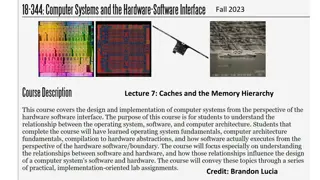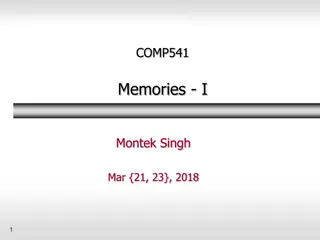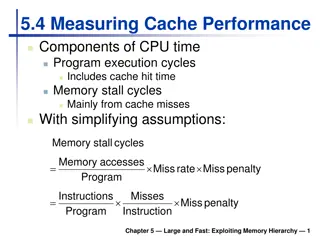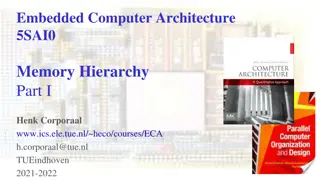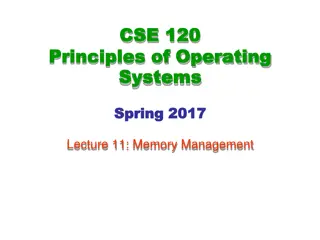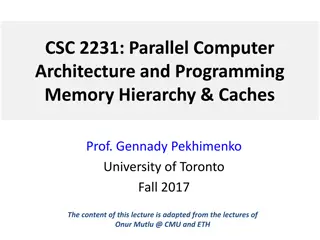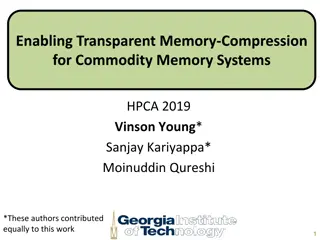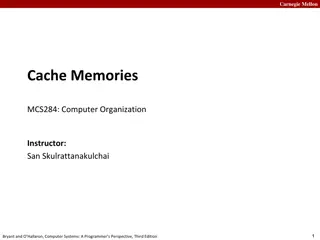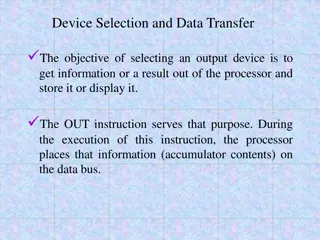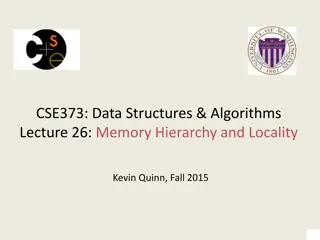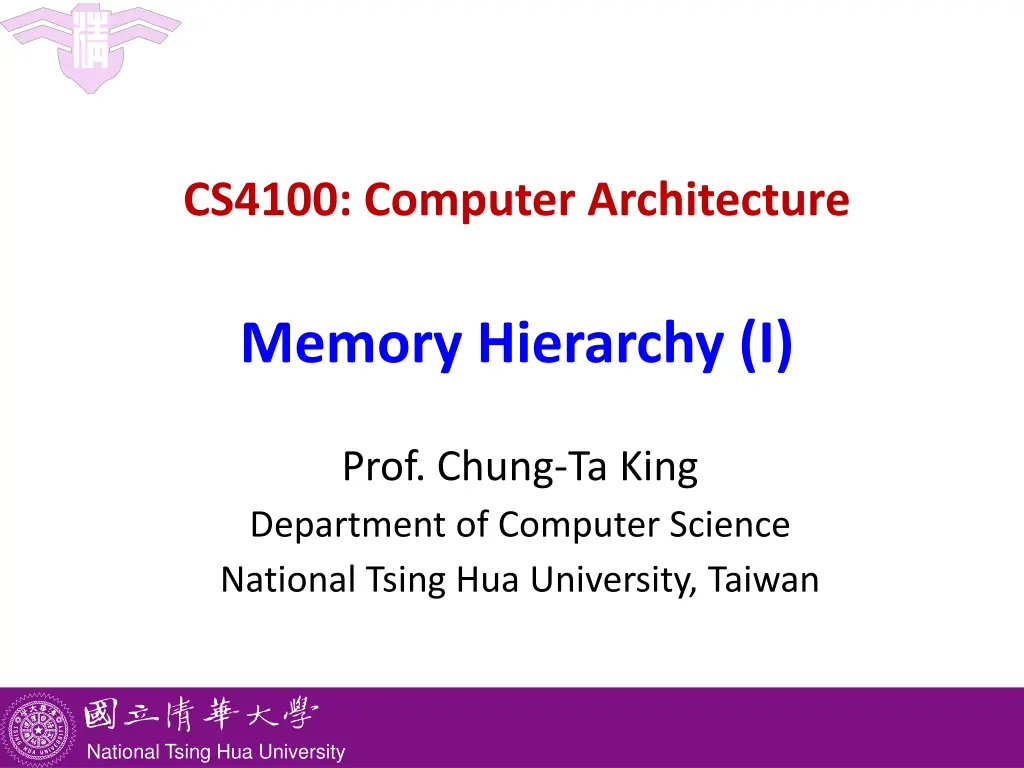
Understanding Computer Architecture Memory Hierarchy for Improved Performance
Discover the intricacies of computer architecture memory hierarchy, its importance, and how it optimizes memory access for faster performance. Explore key concepts like memory technologies, caches, virtual memory, and the principles behind why memory hierarchy works effectively.
Download Presentation

Please find below an Image/Link to download the presentation.
The content on the website is provided AS IS for your information and personal use only. It may not be sold, licensed, or shared on other websites without obtaining consent from the author. If you encounter any issues during the download, it is possible that the publisher has removed the file from their server.
You are allowed to download the files provided on this website for personal or commercial use, subject to the condition that they are used lawfully. All files are the property of their respective owners.
The content on the website is provided AS IS for your information and personal use only. It may not be sold, licensed, or shared on other websites without obtaining consent from the author.
E N D
Presentation Transcript
CS4100: Computer Architecture Memory Hierarchy (I) Prof. Chung-Ta King Department of Computer Science National Tsing Hua University, Taiwan National Tsing Hua University
Outline Introduction to memory hierarchy (Sec. 5.1) Memory technologies (Sec. 5.2, 5.5) Caches (Sec. 5.3, 5.4, 5.9) Virtual memory (Sec. 5.7) Framework for memory hierarchy (Sec. 5.8) Virtual machines (Sec. 5.6) Parallelism and memory hierarchies: cache coherence, redundant arrays of inexpensive disks (Sec. 5.10, 5.11) 1 National Tsing Hua University
Why Memory Hierarchy? Programmers want unlimited amounts of memory with low latency But fast memory more expensive than slower memory Solution: small fast memory + big slow memory = Looks like a big fast memory Big Fast MC MM Small and fast Big and slow 2 National Tsing Hua University
How to Use Memory Hierarchy? Entire addressable memory space available in largest, slowest memory Incrementally smaller and faster memories, each containing a subset of the memory below it, proceed toward processor Upper level: closer to processor (smaller, faster, expensive) Lower level: away from processor (bigger, slower, cheap) Processor chip Control Secondary Storage (Disk) Main Memory (DRAM) L2 Registers On-Chip Cache Datapath Cache 3 National Tsing Hua University
Why Memory Hierarchy Works? Principle of locality: Programs access a small proportion of their address space (data and instruction) at any time a program property Two types of locality: Temporal locality: items accessed recently are likely to be accessed again soon, e.g., instructions in a loop Spatial locality: items near those accessed recently are likely to be accessed soon, e.g., sequential instruction access, array data Stack Code Array Prob. Prob. time Location 4 National Tsing Hua University
How Does It Work? Temporal locality: keep most recently accessed data items closer to the processor (faster reuse) Spatial locality: move blocks consisting of contiguous words to the upper levels (bring in neighbors) Block (or page): basic unit of data transfer Minimum unit of data that can either be present or not present in a level of the hierarchy Lower Level Memory Upper Level Memory To Processor Block Y From Processor 5 National Tsing Hua University
Levels of Memory Hierarchy Capacity Access Time Management Unit Upper Level CPU CPU Registers 100s Bytes <1s cycle faster Registers prog./compiler 1-8 bytes Instr. operands Cache M Bytes 10s cycles Cache cache controller 8-128 bytes Blocks Main Memory G Bytes 100s cycles Memory OS 512-1M bytes Pages Disk T Bytes 1M cycles Disk Larger Lower Level 6 National Tsing Hua University
Hit or Miss Hit: accessed data appears in upper level Hit rate: % of memory accesses found in upper level Hit time: time to access upper level Miss: data not in upper level Miss rate = 1 - (hit rate) Miss penalty: time to replace a block in upper level + time to deliver the block to the processor Hit Time << Miss Penalty Lower Level Memory miss Upper Level Memory Blk X From Processor Blk Y To Processor 7 National Tsing Hua University
4 Questions for Memory Hierarchy Design Q1: Where can a block be placed in the upper level? One fixed location, a few locations, anywhere Q2: How is a block found if it is in the upper level? Depending on strategy taken in Q1 Indexing, table lookup, parallel search Q3: Which block should be replaced on a miss? Ideal: one that not to be used in the farthest future Practical: use the past to predict the future how to track the past? Q4: What happens on a write? Write to upper level only or to lower level as well What if write miss? 8 National Tsing Hua University
Summary of Memory Hierarchy Two different types of locality: Temporal locality (locality in time) Spatial locality (locality in space) Using the principle of locality: Present the user/program with as much memory as is available in the cheapest technology Provide access at the speed offered by the fastest memory End result: provide user/program an illusion of a big fast random access memory 9 National Tsing Hua University
Outline Introduction to memory hierarchy (Sec. 5.1) Memory technologies (Sec. 5.2, 5.5) Dependable memory hierarchy (Sec. 5.5) Caches (Sec. 5.3, 5.4, 5.9) Virtual memory (Sec. 5.7) Framework for memory hierarchy (Sec. 5.8) Virtual machines (Sec. 5.6) Parallelism and memory hierarchies: cache coherence, redundant arrays of inexpensive disks (Sec. 5.10, 5.11) 10 National Tsing Hua University
Memory Technology Random access: access time same for all locations Can access any random location at any time SRAM: Static Random Access Memory Store bits like a flip-flop content will last until lose power Low density, high power, expensive, fast Used for caches DRAM: Dynamic Random Access Memory Store bits in capacitor charges charges will leak and eventually disappear dynamic High density, low power, cheap, slow Used for main memory Word Line (Control) Storage Capacitor Bit Line (Data) 11 National Tsing Hua University
Comparisons of Memory Technologies Memory technology SRAM DRAM Magnetic disk Typical access time 0.5 ~ 2.5 ns 50 ~ 70 ns 5 ~ 20 ms $ per GB in 2008 $2000 ~ $5,000 $20 ~ $75 $0.20 ~ $2 Ideal memory Access time of SRAM Capacity and cost/GB of disk 12 National Tsing Hua University
DRAM Technology Data stored as a charge in a capacitor Single transistor used to access the charge Destructive read and need to write back Bits are organized as a rectangular array An entire row is accessed into a row buffer Must periodically be refreshed Read contents and write back Performed on a DRAM row Word Line (Control) Storage Capacitor Bit Line (Data) bitline Row addr decoder Row addr Col. addr wordline Address Col. addr decoder Row buffer Data out 13 National Tsing Hua University
Advanced DRAM Organizations Burst mode: Supply successive words from row buffer reduce latency Synchronous DRAM: Clocking DRAM interface for repeated transfers without handshaking overhead Double data rate (DDR) DRAM Transfer on rising and falling clock edges DRAM banking: Multiple DRAM banks allowing simultaneous accesses (next slide) https://en.wikipedia.org/wiki/Double_data_rate 14 National Tsing Hua University
DRAM Banking One memory bank CPU Memory Memory Bank Cycle Time Four interleaved memory banks Pipelined access for increased bandwidth Memory bank 0 Memory bank 1 CPU Memory bank 2 Memory bank 3 https://people.rit.edu/meseec/cmpe550-spring2018/ 15 National Tsing Hua University
Flash Storage Nonvolatile semiconductor storage 100 ~ 1000 faster than disk Smaller, lower power, more robust, more $/GB Store bits in floating-gate transistors Apply a voltage VT1< V < VT2 to CG: if transistor on FG uncharged a logic 1 is stored Floating gate (FG) traps charges and changes threshold voltage (VT1 VT2) at control gate (CG) to turn on transistor (By Cyferz at English Wikipedia, CC BY 2.5, https://commons.wikimedia.org/w/index.php?curid=47813471) 16 National Tsing Hua University
Flash Storage NOR flash: bit cell like a NOR gate Random read/write access Used for instruction memory in embedded systems NAND flash: bit cell like a NAND gate Denser and cheaper, block-at-a-time access Used for USB keys, media storage, Flash bits wears out after 1000 s of accesses Wear leveling: remap data to less used blocks H | L X H | H | H _ H | L H | X 17 National Tsing Hua University
Disk Storage Nonvolatile, rotating magnetic storage Spindle Arm Head Actuator Platters 18 National Tsing Hua University
Disk Sectors and Access Each sector records Sector ID Data (512 bytes, 4096 bytes proposed) Error correcting code (ECC) Used to hide defects and recording errors Synchronization fields and gaps Access to a sector involves Queuing delay: if other accesses are pending Seek time: time to move the heads to desired track Rotational latency: time for desired sector under head Data transfer: time to transfer desired sector Controller overhead Track Sector Cylinder Platter Head 19 National Tsing Hua University
Disk Access Example Given 512B sector, 15,000rpm, 4ms average seek time, 100MB/s transfer rate, 0.2ms controller overhead, idle disk Average read time 4ms seek time + / (15,000/60) = 2ms rotational latency + 512 / 100MB/s = 0.005ms transfer time + 0.2ms controller delay = 6.2ms If actual average seek time is 1ms Average read time = 3.2ms 20 National Tsing Hua University
Outline Introduction to memory hierarchy (Sec. 5.1) Memory technologies (Sec. 5.2, 5.5) Dependable memory hierarchy (Sec. 5.5) Caches (Sec. 5.3, 5.4, 5.9) Virtual memory (Sec. 5.7) Framework for memory hierarchy (Sec. 5.8) Virtual machines (Sec. 5.6) Parallelism and memory hierarchies: cache coherence, redundant arrays of inexpensive disks (Sec. 5.10, 5.11) 21 National Tsing Hua University
What Is Failure? Given a specification of proper service Service accomplishment Service delivered as specified Failure may be permanent or intermittent Restoration Failure Service interruption Deviation from specified service Fault: failure of a component, may or may not cause failure National Tsing Hua University
Reliability vs. Availability Reliability: a measure of continuous service accomplishment (or the time to failure), starting from a reference point Mean time to failure (MTTF): a reliability measure Mean time to repair (MTTR): a measure of service interruption Mean time between failures (MTBF): = MTTF + MTTR Availability: a measure of service accomplishment with respect to the alternation between the two states of accomplishment and interruption Availability = MTTF / (MTTF + MTTR) National Tsing Hua University
Reliability vs. Availability We want high availability (HA) Can be expressed as # of nines of availability per year One nine: 90% 36.5 days of repair/year Five nines: 99.999% 5.26 minutes of repair/year HA can be achieved by Reducing MTTR: improved tools and processes for fault detection, diagnosis and repair Increasing MTTF: improve quality of components or design systems to continue operation in the presence of components that have failed Fault avoidance: reliable components Fault tolerance: redundant components Fault forecasting: predict and replace before failure National Tsing Hua University
Fault Tolerance for Memory Hamming Single Error Correcting, Double Error Detecting Code (SECDED) Hamming distance: Minimum number of bits that are different between any two correct bit patterns A measure of how close correct bit patterns can be e.g., Hamming distance between 011011 and 001111 is two Single Error Detecting Code: A set of legal bit patterns that can detect single bit error Condition: if only every pair of legal bit patterns has a Hamming distance of 2, e.g., parity code Fault tolerance with extra, redundant bits National Tsing Hua University
Single Error Detecting Code The simplest way to encode four different things: 00 01 But, which bit is in error? 10 11 Suppose you send the code 01 to ask your friend to bring you a banana, but the code was erroneously transmitted as 11 Can she/he tell there is a bit error? How about this code? 000 011 Even parity 101 110 National Tsing Hua University
Single Error Correcting (SEC) Code A code with a Hamming distance of 3 provides single error correction (Why?) Hamming Error Correction Code (ECC): Number bits from 1 on the left All bit positions that are a power 2 are parity bits Each parity bit checks group of data bits via even parity: National Tsing Hua University
Single Error Correcting (SEC) Code Sum of positions of erroneous parity bits identifies the erroneous bit, e.g., Parity bits = 0000 indicates no error Parity bits = 1001 bit 1+8=9 was flipped Example: Encode 100110102 _ _ 1 _ 0 0 1 _ 1 0 1 0 ? Position 1 should make bits 1,3,5,7,9,11 even parity _ _ 1 _ 0 0 1 _ 1 0 1 0 p1 = 0 Final code word = 011100101010 If we detect bit pattern 011100101110, which bit is error? Groups protected by p1 and p4 are even parity But, groups protected by p2 and p8 are odd parity 2 + 8 = 10 and the 10th bit is in error and can be corrected How to tell if 1- or 2-bit error? National Tsing Hua University
SECDED Single error correcting, double error detecting (SECDED) Add an additional parity bit for the whole word (pn) Final code word = 011100101010 0 This makes Hamming distance = 4 (so?) Decoding: let H = SEC parity bits (p1p2p4p8) H even, pn even no error H odd, pn odd correctable single bit error (as in SEC) H even, pn odd error in pn bit H odd, pn even double error occurred Note: ECC DRAM uses SECDEC with 8 bits to protect each 64-bit data in memory National Tsing Hua University









